Pros and Cons of Bibo Eggplant & Growing Guide
Growing eggplant - a painstaking and laborious business. This culture is capricious and requires constant care. However, the Bibo f1 hybrid is unpretentious in maintenance and at the same time highly productive. White color its fruit attracts many gardeners.
Consider how to grow this crop so that the effort and time spent will be rewarded with a rich harvest of delicious vegetables.
The content of the article
Description of culture
Bibo is a first generation hybrid. It was created by the breeders of the Dutch company Monsanto.
The f1 hybrid adapts well to adverse conditions, temperature extremes, and is relatively resistant to diseases and pests. All this contributes to high yields. The vegetable is grown both in the south of Russia and in the north.
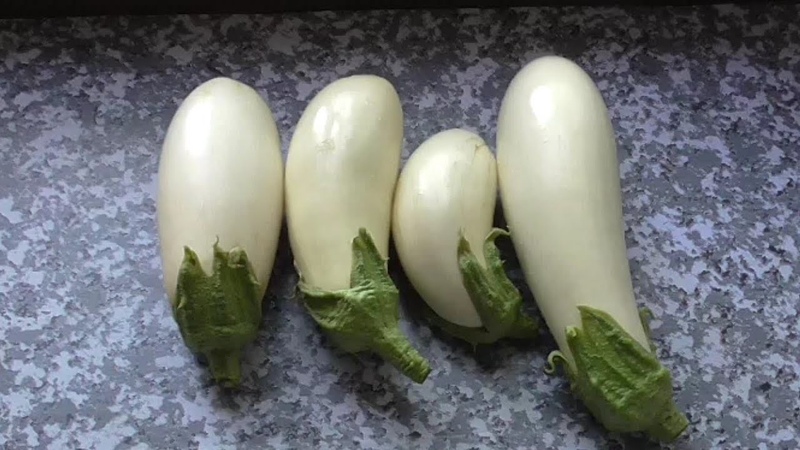
Distinctive features
Plants have the following characteristics:
- short internodes, contributing to the formation of a large number of ovaries;
- early and rich harvest;
- powerful root system.
Vegetables grow quickly (75–90 days after the first shoots appear), take root well and bear fruit under any conditions. The yield reaches 4.8 kg per 1 m2, and the harvested fruits stored for a long time.
Specifications
It is an early maturing crop, resistant to fusarium and tobacco mosaic. Semi-spreading bushes, green leaves with wavy edges. The stem is of medium thickness, slightly pubescent. The flowers are purple, small in size.
Features of the fruit:
- oval-conical shape, even;
- the skin is dense, tender, elastic, white, has a slight sheen;
- the pulp is white, firm, not bitter;
- fruit weight - from 190 to 210 g (there are even more);
- diameter - 7–8 cm, length - 15–18 cm;
- excellent taste;
- versatility in cooking.
How to grow yourself
Cultivating Bibo f1 eggplants is not difficult. It is important to follow certain rules at all stages of caring for them.
Growing seedlings
Seedlings begin to grow 2 months before planting - in February-March. Hybrid seeds are usually already processed by the manufacturer, but if there is no corresponding mark on the package, the material is prepared for sowing on its own. First, they are soaked in a saline solution and the floating grains are removed. Then they are treated with a weak solution of potassium permanganate for disinfection.
After the preparation stage, the seeds are planted. Basic rules for growing:
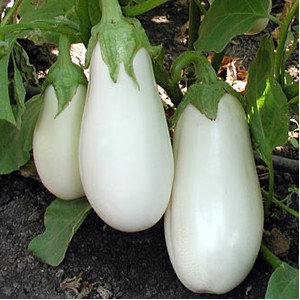
- Separate containers with a volume of 400-450 ml are used for seedlings.
- The soil is chosen loose and nutritious (black soil and peat with sand, soil with biohumus are suitable).
- Maintain a temperature of + 20 ... + 25 ° C, otherwise the seeds will not germinate. With the correct values, sprouts appear after 10 days.
- Water the seedlings only with warm water.
- With the appearance of the first sprouts, the containers are transferred to a warm, lighted place.
- With the first leaves, the culture is fertilized.
Transfer
The beds are chosen on a lighted hill. Mineral fertilizers are applied to the ground. Compost or manure is added in autumn: 1 bucket of fertilizing per 1 m2.
For transplantation to a permanent place, pits are dug up to a depth of 10-15 cm, warm water or mullein solution is poured into them.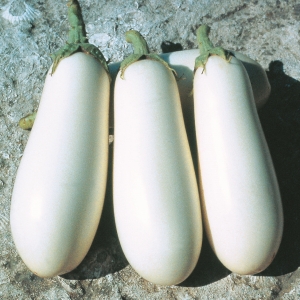
Bushes with 4-5 leaves are transplanted in cloudy weather, at + 14 ... + 15 ° C (in May – June). For the first 3 days, they are sheltered from the sun. When transplanting into a greenhouse, more adult seedlings are used - with 5-6 leaves.
Planting scheme: the distance between the rows is about 65 cm, between the plants is about 35 cm. There are 4-6 bushes per 1 m2. If you plant them closely, the harvest will be meager. Sowing depth - no more than 2 cm.
In the open field, Bibo f1 is grown under film shelters. During the period of fruit formation, they are tied to a vertical support.
Important! Good crop precursors are carrots, melons, legumes, dill and lettuce.
Further care
Bibo eggplant responds well to fertilizers and gives a rich harvest. If the seedlings are greenhouse, more fertilizing is required (3-4 times per season):
- For the first time, fertilize with nitrophos 14 days after planting (50 g per 5 liters of water, watered with 1 liter per bush).
- The next top dressing is before flowering. They use "Kemiru" or "Kristalon".
- The same compositions are fertilized at the stage of ovary formation.
- The last dressing with phosphorus and potassium is applied after collecting the first fruits and repeated after 2 weeks.
Features of cultivation and possible difficulties
The culture tolerates temperature fluctuations well, but for the best yields in the northern regions it is grown in greenhouses or under a film shelter.
Important! The soil should always be moist. Water the beds 2 times a week to prevent crust formation on the ground.
Basic rules for irrigation:
- the culture is abundantly watered during the flowering period and the formation of ovaries;
- after each moistening, the soil is loosened;
- bushes are sprayed with pest preparations.
Loosen the soil carefully, without touching the roots. Otherwise, the eggplants may die.
Diseases and pests
Bibo eggplants, like many vegetable crops, suffer from the Colorado potato beetle, spider mites and aphids.
Insect control tips:
- Insecticides are used against pests, which quickly decompose in the ground. So there will be less harm to vegetables.
- If slugs appear, they are removed by hand. A mixture of lime, ash and tobacco dust is scattered between the beds.
- For prevention, basil, calendula or marigolds are planted next to the eggplants. Their smell repels pests.
Bibo is resistant to fusarium and tobacco mosaic virus, but susceptible to late blight, a fungal disease that appears with excess moisture. For treatment, Bordeaux liquid, a solution of copper sulfate or the drug "Antracol" are used.
Important! After processing, the fruits can be consumed only after 10 days.
An excess of liquid causes blackening of the stem and death of the plant. Therefore, it is important to observe the irrigation regime and monitor the soil moisture.
Harvesting and application of the crop
From germination to harvest, 100–120 days pass. The first fruits of the culture are in August – September.
Important! The strong stem of the eggplants is not torn off, but cut off with a pruner at a distance of 4-5 cm from the base of the fruit.
Bibo fruits contain potassium, calcium, phosphorus and iron, so they are useful for preventing heart disease, anemia, and strengthening the skeletal system.
Eggplants are widely used in home cooking: they are grilled or cooked in the oven. They make casseroles, side dishes, snacks and preparations for the winter.
Advantages and disadvantages
The hybrid has many advantages: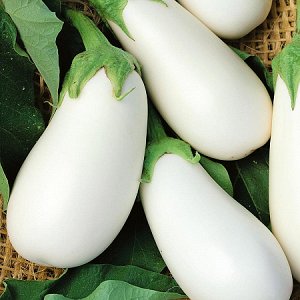
- the possibility of growing in open ground and in a greenhouse;
- high yield;
- unpretentious care;
- resistance to certain diseases;
- lack of bitterness in the pulp of the fruit;
- good transportability;
- long-term storage.
Disadvantages of culture:
- bushes must be tied up;
- the seeds collected from the hybrid do not have the qualities of the previous generation, so they are bought every year.
Reviews
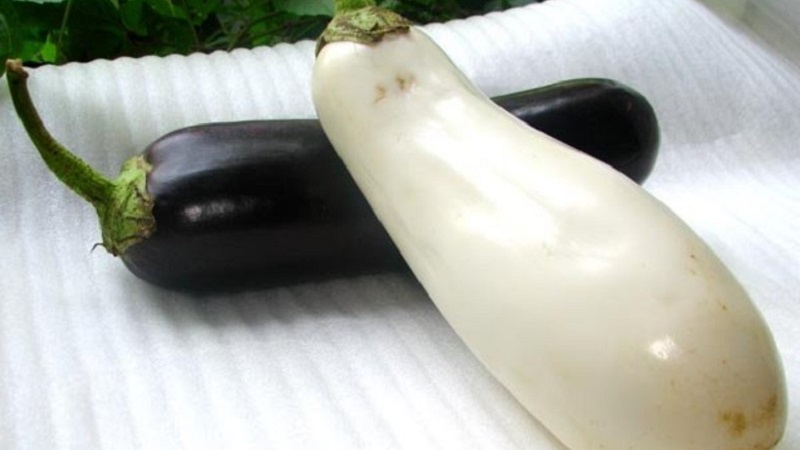
Many gardeners have been growing Bibo f1 for several years. Here are just some of the reviews:
Svetlana Suleimanova, Orenburg: “I really enjoy growing these particular eggplants. They ripen before the rest, so we collect them with the whole family and enjoy the taste. "
Andrey Lipnitsky, St. Petersburg: “I have been planting bibo for 4 years now: it has many advantages (early harvest, unpretentiousness, taste). I also like the white color of eggplants, as in the photo, although many friends are surprised by it. "
Alisa Semenova, Tyumen: “Bibo's eggplants make wonderful dishes. I especially like to make a vegetable casserole - the children and husband are delighted! "
Conclusion
Growing eggplants in the garden is laborious, but with the Bibo hybrid, the process is simplified. The culture does not require constant maintenance, it is resistant to adverse weather conditions, therefore it is grown both indoors and outdoors. The high yield of large and tasty white fruits (up to 4.8 kg per m2) will delight many. The pulp of vegetables is not bitter, it is universal in cooking.